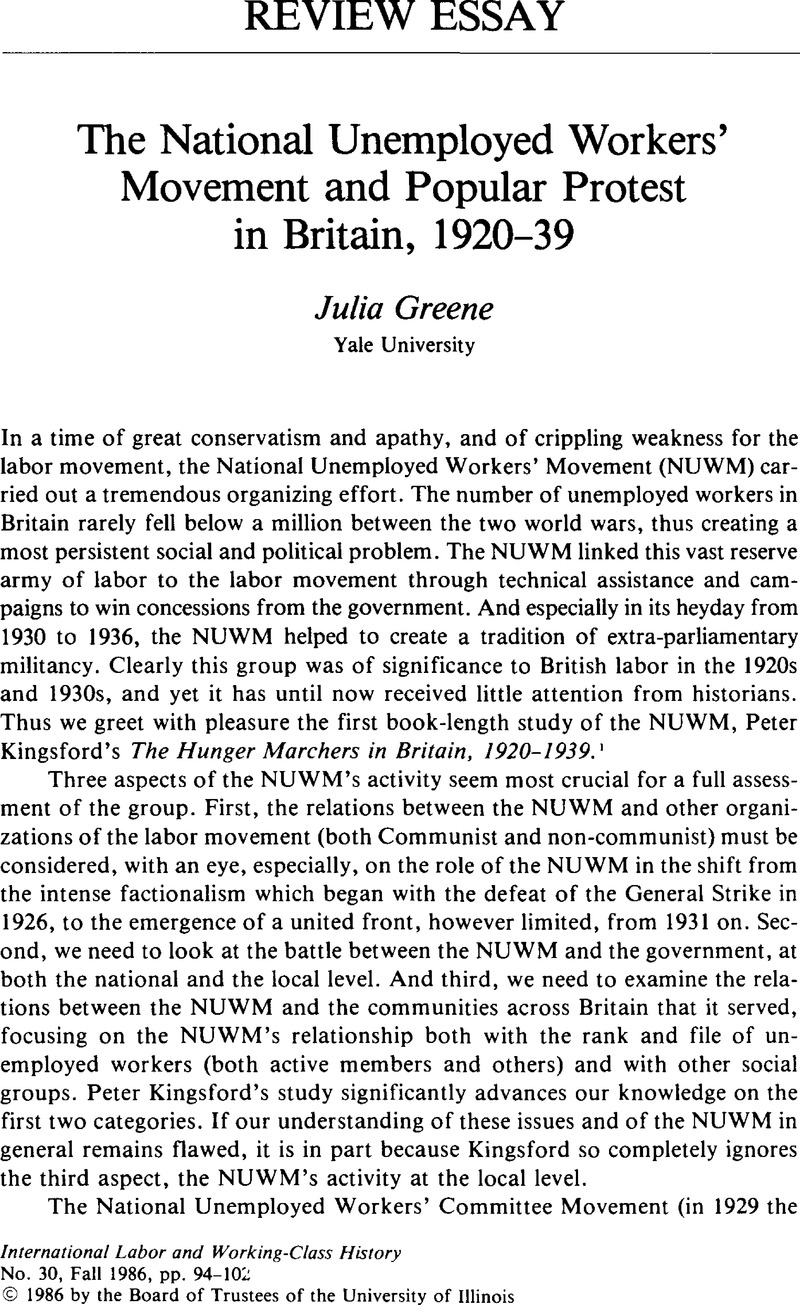Article contents
The National Unemployed Workers' Movement and Popular Protest in Britain, 1920–39
Published online by Cambridge University Press: 16 December 2008
Abstract

- Type
- Review Essay
- Information
- Copyright
- Copyright © International Labor and Working-Class History, Inc. 1986
References
NOTES
1. London: Lawrence and Wishart, 1982, 244 pp. Kingsford's title is not completely precise: His subject is those national hunger marches organized by the NUWM. He does not deal significantly with the one major march not led by the NUWM, the Jarrow March. He also spends little time on the many regional marches organized by the NUWM.
2. See Hayburn, Ralph, “The Police and the Hunger Marchers,” International Review of Social History 17 (1972, pt. 3): 626.CrossRefGoogle Scholar South Wales was one of the most important exceptions to this pattern.
3. Kingsford, 84.
4. Hayburn, , “The National Unemployed Workers' Movement, 1921–36: A Re-Appraisal,” International Review of Social History 18 (1983, pt. 3): 293.Google Scholar
5. The 1930 march was the major exception: although the NUWM wanted to organize 1,000 marchers, only 350 people willing to march against a Labour Government could be found.
6. Mowat, Charles L., Britain Between the Wars, 1918–1940 (London, 1955), 433, 463.Google Scholar
7. Paynter, , My Generation (London, 1972), 85.Google Scholar Greene, Julia, “The National Unemployed Workers' Movement in the South Wales Coalfield, 1930 to 1936” (unpublished ms., 1982), 17.Google Scholar
8. Turnbull, Maureen, “Attitude of Government and Administration towards the ‘Hunger Marches’ of the 1920s and 1930s,” Journal of Social Policy 2 (04 1973): 142.CrossRefGoogle Scholar
9. Stevenson, John and Cook, Chris, The Slump: Society and Politics during the Depression (London, 1977), 161.Google Scholar
10. See for example, Stevenson and Cook; Hayburn, (1983), 290.Google Scholar
11. Francis, Hywel and Smith, David, The Fed: A History of the South Wales Miners in the Twentieth Century (London, 1982), 146.Google Scholar Despite any later divergence between the CP and the NUWM, Horner's statement expressed a principle which local NUWM activists continued to find appealing. For more on this point see Greene, “The N.U.W.M. in the South Wales Coalfield,” 26–31.
12. Ibid., 248, 250.
13. Ibid., 104.
14. See Eley, Geoff and Nield, Keith, “Why does Social History Ignore Politics?” Social History 5 (05 1980): 249–71CrossRefGoogle Scholar; Fox-Genovese, Elizabeth and Genovese, Eugene, “The Political Crisis of Social History,” in Fruits of Merchant Capital: Slavery and Bourgeois Property in the Rise and Expansion of Capitalism, ed. Fox-Genovese, and Genovese, (Oxford, 1983), 179–212.Google Scholar
15. Turnbull; Stevenson and Cook, especially 135–65; Stevenson, John, “The Politics of Violence,” in The Politics of Reappraisal, 1918–1939, ed. Cook, Chris and Peale, Gillian (London, 1975), 146–65CrossRefGoogle Scholar; Hayburn, (1972).Google Scholar
- 1
- Cited by




